英语阅读说课课件
人教版(PEP)小学英语四年级上册第四单元Unit 4 Read and write阅读课说课课件

Activity 1: Retell
Step 2 应用实践
This is Wu Binbin’s
living room. The
are on
on / in under near
Activity 8: Any problems? Step 1 学习理解 Can you find them?
Activity 9: Shadow reading
Step 1 学习理解
This is my living room.
My books are on the sofa, and my pens are on the fridge. My bag is under the table,
Activity 3: What can you find? Step 2 应用实践
Activity 4: Say and write your room.
Step 2 应用实践
living room bedroom study bathroom kitchen
glasses table
Looking for bed
John’s keys
This is the…I can…
The …is on/in/under…
Step 1 学习理解
Activity 4:Read quickly and circle. What is in Wu Binbin’s living room?
2.小组内解决不了的,写纸条交给老师。
Step 1 学习理解
人教新课标高中英语必修四Unit Working the land reading说课 课件
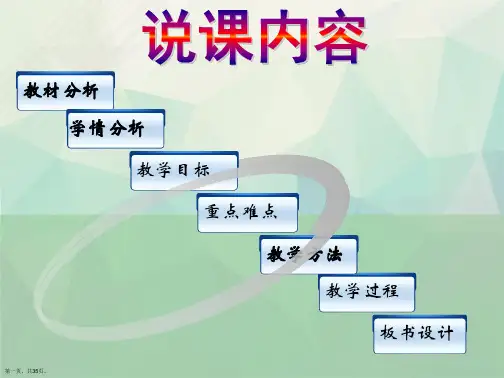
Hunger
Six million children under the age of five die every year as a result of hunger. One child dies every five seconds.
Seeing this, what can we do?
Do you know the Chinese poem?
第八页,共35页。
第九页,共35页。
fertilizing
ploughing
irrigating
seeding
winnowing
第十页,共35页。
transplanting
havesting
Ploughing 犁田
Seeding播 种
Fertilizig 施肥
第十二页,共35页。
If there was no rice one day, what would happen?
第十三页,共35页。
If that happened, people might die of hunger. The whole world would get into trouble.
a. He was born into a poor farmer’s family in 1930 .
b. He graduated from Southwest Agricultural college. c. In 1950, Chinese farmers produced 50 million
Which of the following description about Dr Yuan’s personality is not true? A. He is satisfied with his life because he is
高中英语阅读课公开课说课稿。一等奖
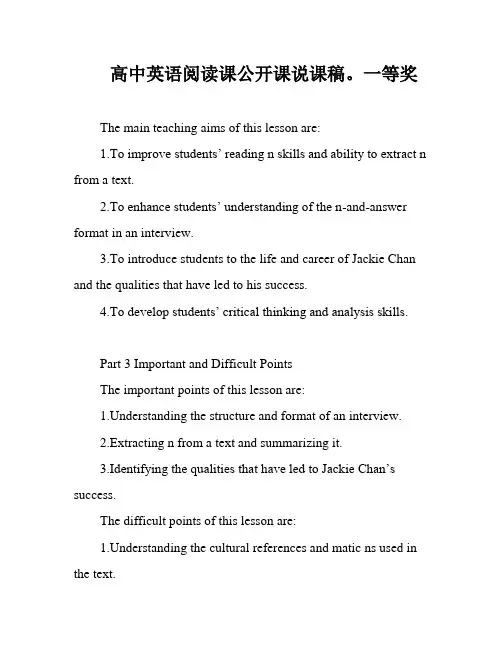
高中英语阅读课公开课说课稿。
一等奖The main teaching aims of this lesson are:1.To improve students’ reading n skills and ability to extract n from a text.2.To enhance students’ understanding of the n-and-answer format in an interview.3.To introduce students to the life and career of Jackie Chan and the qualities that have led to his success.4.To develop students’ critical thinking and analysis skills.Part 3 Important and Difficult PointsThe important points of this lesson are:1.Understanding the structure and format of an interview.2.Extracting n from a text and summarizing it.3.Identifying the qualities that have led to Jackie Chan’s success.The difficult points of this lesson are:1.Understanding the cultural references and matic ns used in the text.2.Anal yzing the author’s tone and purpose in the interview.Part 4 Studying MethodsTo achieve the teaching aims。
高中英语阅读课公开课说课稿---一等奖.
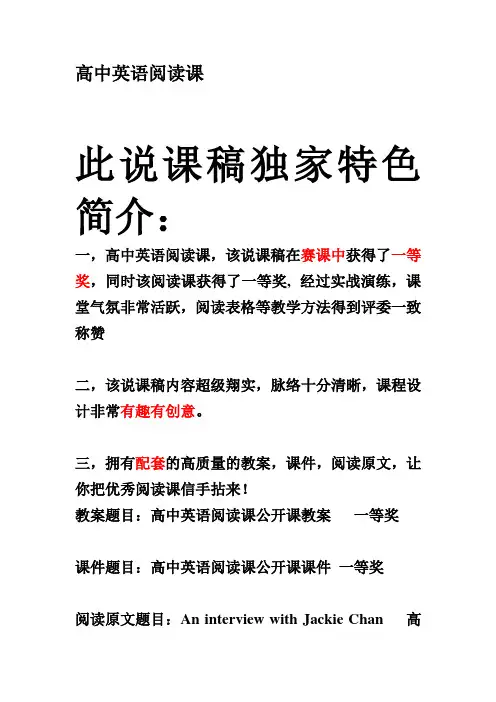
高中英语阅读课此说课稿独家特色简介:一,高中英语阅读课,该说课稿在赛课中获得了一等奖,同时该阅读课获得了一等奖,经过实战演练,课堂气氛非常活跃,阅读表格等教学方法得到评委一致称赞二,该说课稿内容超级翔实,脉络十分清晰,课程设计非常有趣有创意。
三,拥有配套的高质量的教案,课件,阅读原文,让你把优秀阅读课信手拈来!教案题目:高中英语阅读课公开课教案一等奖课件题目:高中英语阅读课公开课课件一等奖阅读原文题目:An interview with Jackie Chan 高中英语阅读课公开课原文InterpretationGood morning, ladies and gentlemen. It’s my great honor and pleasure to be here sharing my lesson with you.I have been ready to begin this representation with five parts. Analysis of the teaching material, the teaching aims, the important and difficult points, the studying methods, and the teaching procedure.Part 1 Teaching MaterialThe content of my lesson is a reading material, through the learning of which, I’ll enable students to know more about Jackie Chan, his life career and the qualities that lead to his success. At the same time, make Ss aware of the question-and-answer format in an interview and learn how to conclude a question from the answer.Part 2 Teaching AimsAccording to the new standard curriculum and the syllabus (新课程标准和教学大纲), and after studying the teaching material, the teaching aims are the followings:1.Knowledge objects (语言目标:语音,词汇,语法,功能,话题)(1)The Ss can learn question-and-answer format in an interview.(2) The Ss can understand the content of the lesson, talk about Jackie Chan’s life career andform their own opinion about success.2.Ability objects (技能目标:听,说,读,写)(1) To develop the Ss’ abilities of listening, speaking, reading and writing(2) To improve Ss' reading abilities, especially their skimming and scanning abilities.(3) To train the Ss’ abilit ies of studying by themselves and through cooperating.3.Emotion or moral objects (情感目标:兴趣,自信,合作,爱国,国际视野)Learn from Jackie Chan and understand the way to success is not smooth. Put the moral education in the process of study.Part 3 the Important and Difficult PointsThe important points are what qualities are required to be successful? Such as creativity, persistence and talent.The difficult points are Help students to conclude the questions of interviewers according to Jackie Chan’s answers.Part 4 Teaching MethodsAs is known to us all, a good teaching method requires that the teacher should help Ss develop good sense of the English language. For achieving these teaching aims,(after the analysis of the teaching material and teaching aims,) I will use the following methods according to the modern social communication teaching theories.municative Approach(交际教学法)2.Task-based Language Teaching (任务教学法)3.Total Situational Action (情景教学) a “scene —activity”teaching method , it establishes a real scene and the interaction between the teacher and the Ss. At the same time, CAI (电脑辅助教学) can provide a real situation with its sound and picture, it can develop the Ss creativity in learning English.Part 5 Teaching ProcedureStep 1. Lead-in. (3min)Greeting and play a related videoPurpose of my design:To arouse students' interest and lead in the topic for this lesson.Step 2. Pre-readingTask 1. (Individual work, pair work, group work, class work; 8min)Let Ss Get Ss to know something about Jackie Chan.Step 3. While-reading 22minTask 1.Skimming: Ss should read the material fast to conclude the possible questions Task 2.Scanning: Say what the comments tell you about Chan’s attitude to himself and his career. Step 4. Post-reading 12minTask 1Let Ss make further discussionTask 2. BrainstormDoes the interviewer tell you what you want to know about Jackie Chan? If Jackie Chan comes to our school and you will interview him on behalf of our school, what questions will you ask him?Step 5. HomeworkWhat do you think is the most important quality to be successful? Relate it to how to be successful in college entrance examination.Write down your opinion in the form of an essay. (120 words)。
《英语阅读》课程说课稿
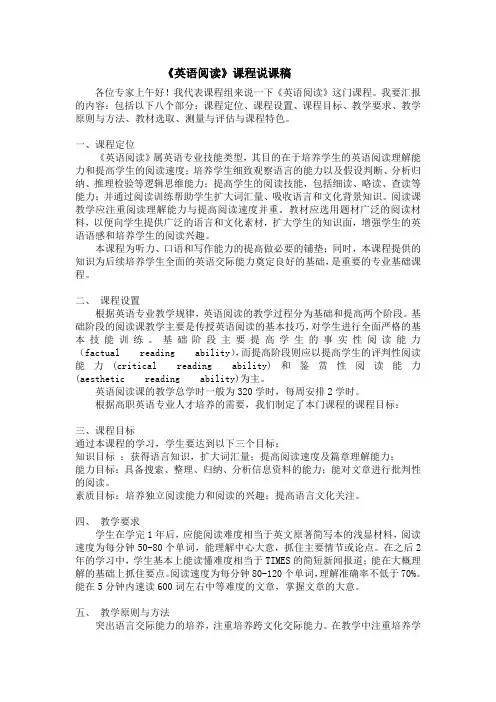
《英语阅读》课程说课稿各位专家上午好!我代表课程组来说一下《英语阅读》这门课程。
我要汇报的内容:包括以下八个部分:课程定位、课程设置、课程目标、教学要求、教学原则与方法、教材选取、测量与评估与课程特色。
一、课程定位《英语阅读》属英语专业技能类型,其目的在于培养学生的英语阅读理解能力和提高学生的阅读速度;培养学生细致观察语言的能力以及假设判断、分析归纳、推理检验等逻辑思维能力;提高学生的阅读技能,包括细读、略读、查读等能力;并通过阅读训练帮助学生扩大词汇量、吸收语言和文化背景知识。
阅读课教学应注重阅读理解能力与提高阅读速度并重。
教材应选用题材广泛的阅读材料,以便向学生提供广泛的语言和文化素材,扩大学生的知识面,增强学生的英语语感和培养学生的阅读兴趣。
本课程为听力、口语和写作能力的提高做必要的铺垫;同时,本课程提供的知识为后续培养学生全面的英语交际能力奠定良好的基础,是重要的专业基础课程。
二、课程设置根据英语专业教学规律,英语阅读的教学过程分为基础和提高两个阶段。
基础阶段的阅读课教学主要是传授英语阅读的基本技巧,对学生进行全面严格的基本技能训练。
基础阶段主要提高学生的事实性阅读能力(factual reading ability),而提高阶段则应以提高学生的评判性阅读能力(critical reading ability)和鉴赏性阅读能力(aesthetic reading ability)为主。
英语阅读课的教学总学时一般为320学时,每周安排2学时。
根据高职英语专业人才培养的需要,我们制定了本门课程的课程目标:三、课程目标通过本课程的学习,学生要达到以下三个目标:知识目标:获得语言知识,扩大词汇量;提高阅读速度及篇章理解能力;能力目标:具备搜索、整理、归纳、分析信息资料的能力;能对文章进行批判性的阅读。
素质目标:培养独立阅读能力和阅读的兴趣;提高语言文化关注。
四、教学要求学生在学完1年后,应能阅读难度相当于英文原著简写本的浅显材料,阅读速度为每分钟50-80个单词,能理解中心大意,抓住主要情节或论点。
高中英语阅读课英文说课稿
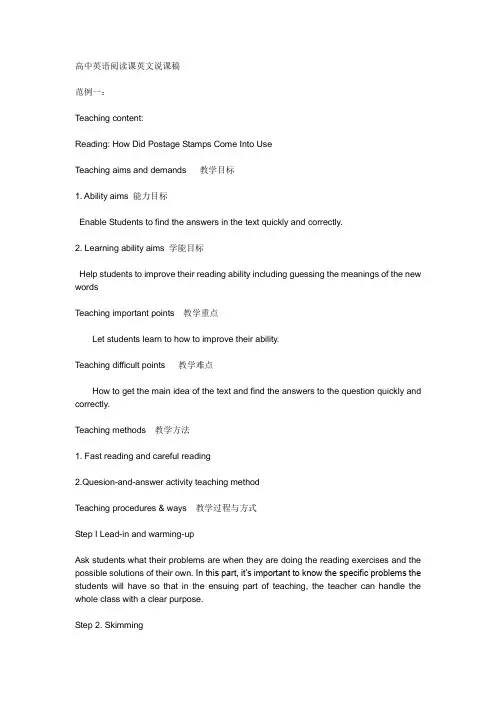
高中英语阅读课英文说课稿范例一:Teaching content:Reading: How Did Postage Stamps Come Into UseTeaching aims and demands 教学目标1. Ability aims 能力目标Enable Students to find the answers in the text quickly and correctly.2. Learning ability aims 学能目标Help students to improve their reading ability including guessing the meanings of the new wordsTeaching important points 教学重点Let students learn to how to improve their ability.Teaching difficult points 教学难点How to get the main idea of the text and find the answers to the question quickly and correctly.Teaching methods 教学方法1. Fast reading and careful reading2.Quesion-and-answer activity teaching methodTeaching procedures & ways 教学过程与方式Step I Lead-in and warming-upAsk students what their problems are when they are doing the reading exercises and the possible solutions of their own. In this part, it’s important to know the specific problems the students will have so that in the ensuing part of teaching, the teacher can handle the whole class with a clear purpose.Step 2. Skimming1. InstructionsGive students a passage to read and write a question “Who put forward the proposal to use stamps.” on the blackboard. Ask students read the passage quickly and find the answer. Limit the time to only two and a half minutes.(这一部分旨在教会学生略读方法,快速通篇阅读文章,抓住大意,纠正逐字阅读的错误方法,并找到问题的答案)2. Handing out the reading materialReading Material:How Did Postage Stamps Come Into UseWhen you send a letter or a postcard, you have to put stamps on the envelope or on the card. When did people first begin to use stamps? Who was the first to think of this idea? In the early nineteenth century, people did not use stamps. They had to pay postage when they received letters. They were unhappy about this, especially when they paid for a letter which they did not wish to receive at all. The postage was high at that time, because the post offices had to send many people to collect the postage.Rowland Hill, a schoolmaster in England, was the first to put forward a proposal to use stamps. He thought it would be much easier for people to use stamps to cover postage. They could go to the nearby post office to buy stamps and put them on envelopes before they sent the letters. The post office could simply put seals on the stamps so that people could not use the stamps again. In this way, the post office did not need to send postmen to collect postage. It only needed to send fewer postmen to deliver letters. That was a good idea and the government finally accepted it.On May 6, 1840, post offices throughout England began to sell stamps. Soon this new postal system was taken up by other countries. Now each country has its own stamps. And there are many people who collect stamps all over the world.3. CheckingQ: Who put forward the proposal to use stamps.A: Rowland Hill, a schoolmaster in England.4.Conclusion检查学生是否在限定的两分半的时间里是否通篇阅读完文章,并且找到了答案,摒弃逐字阅读方法,通过略读抓住文章大意Step 3. ScanningGive three minutes to read the passages again and find the answers to the two questions.1. Why was the postage high in the early nineteenth century when people did not use stamps?2. When was postage stamps first put to use?Ans. to Que.1. Because the post offices had to send many people to collect the postage. Ans. to Que.2. On May 6, 1840.Concusion在上一步骤的基础上,再次阅读文章,授于寻读方法,即寻找问题的语句在文章中出现的位置,根据原句回答所给的问题。
新人教版英语必修一_Unit 2 阅读课-说课课件
2
Learners’ interaction
3
Communicat ive teaching method
VI Analysis of teaching procedures
7 minutes
Stage 1: Lead-in
20 minutes
Stage 2: Top-down reading
13 minutes
Stage 3: Production
VI Analysis of teaching procedures
Stage 1: Lead-in
Step 1: Video Welcome to Peru Step 2: Brainstorming activity
The design of the stage is a process where the learners’ interests are raised and construct meaning based on their own experience and what they have already known.
Linguistic objectives
Skill objectives
Emotional objectives
know the key words improve reading skills and phases
IV Analysis of teaching focus
Key point:
Learn about the features of travel brochures
Teaching focus
Difficult point:
compare the four different places and give specific suggestions
小学英语阅读课说课稿英文版
小学英语阅读课说课稿英文版Background of English teaching in primary school: It is not a long history that English is as a subject in primary school in our country and the main instructional aims of teaching English in primary school is to cultivate pupils’ basic abilities of their listening and speaking and their good sense of the English language. Our boys and girls are exposed to English for the first time, so it is very important to develop their keen interest in English.I. Contents:Today I’m going to talk about Part B of Unit 2, PEP Primary English, Book 3. This lesson includes two parts: Let’s talk and let’s practice. In section 1, it mainly deals with the dialogue about “What’s in the s choolbag?” and the answers. And in section 2, it provides a real situation for the Ss to prastise the pattern: How many +n.(pl.)+ do you have? And the answer: I have 23 +n.(pl.)II. Teaching aims1. Aims on the knowledge(1) To enable the Ss to un derstand and speak: “My schoolbag is heavy. What’s in it? Thank you sooooooo much.” Make sure that Ss can use these sentences in real situations.(2) To help Ss to finish the survey.(3) Let Ss finish the assessment of “Let’s check” in this unit.2. Aims on the abilities(1) To develop Ss’ abilities of listening and speaking.(2) To train the Ss’ ability of working in groups.(3) To foster Ss’ abilities of communication and their innovation.3. Aims on the emotion(1)To foster Ss’ consciousness of good co-operation and proper competition.(2) To lead Ss to show their loveliness to the poor.III. Key-points of this lesson(1) To help Ss ask and answer the question: What’s in it?(2) To enable Ss to study in groups and co-operate skillfully.(3) To develop Ss’ interest in English.IV. Difficult points(1) To help the Ss ask and answer the question “What’s in it?” and make sure they can use the plural nouns correctly.(2) To finish the survey by themselves.V. Teaching methodsAs we all know: the main instructional aims of learning English in primary school is to cultivate pupils’ basic abilities of listening and speaking and their good sense of the English language. So in this lesson I’ll mainly use “Task-based” teaching method. That is to say, I will letthe Ss learn in real situations, finish a task by making a survey to help the Ss to get a better understanding of the key structure of the dialogue. I will arrange four kinds of activities: singing, guessing game, finishing a survey and having a competition. And in this lesson a recorder, CAI, school things and a printed form will be needed. Students should prepare some school things.VI. Teaching procedures and purposes of my designing.I’ll finish this lesson in five steps.Step 1. Warm-up and preview1. Free talk between T and Ss about things in the classroom.2. Sing the song together: Books and pencils.3. Do some TPR, for example: Show me your English book. Show me your crayon.4. Review the numbers by asking: “How many crayons do you have?”Purpose: It is important to form a better English learning surrounding for the Ss by singing and doing some total physical response and at the same time it provides situations to review learned knowledge for the next step.Step 2. PresentationNow I’ll mainly talk about this step.1. Present the pattern: “My schoolbag is heavy.” “What’s in it?.”(1) Show a bag and say: “Look! I have a bag.” Carry it and say: “Oh, it is heavy. My schoolbag is heavy.” Help the Ss understand the meaning with the help of my body language. Then lead the Ss to read the sentence. Make sure they can say it correctly.(2) T: My schoolbag is heavy.Open the bag and say: “What’s in it? What’s in my schoolbag?”Take out a Chinese book. Then do the action again. Let the Ss read the sentence.2. Play a guessing game. Divide the whole class into four groups to have a competition.Let them guess: What’s in the bag? How many? Purpose: To present the key structures one by one is much easier for the Ss to learn and grasp the meanings. Proper competition can arouse the Ss’ interest in English learning.3. With the help of the CAI to present the dialogue. Set a situation to help Ss understand: Two Ss are coming. One girl is carrying a heavy bag on her back. They are talking.Girl: My schoolbag is heavy.Boy: What’s in it?Girl: 20 story-books, 32 pencil, 9 rulers, 12 crayons and 30 picture-books. Etc.Boy: What will you do?Girl: They are for the poor.Bo y: Great! I’ll bring some school things too.The boy comes back home and puts a lot of things into the bag. Then he goes to school again and gives them to a teacher. While he is taking them out, he is counting the numbers of all things. The teacher says: Thank you soooooooo much.4. Mention that we should take care of the poor.5. Play the cassette. Let the Ss listen and imitate the dialogue.Pay attention to their pronunciation and intonation. Purpose: CAI can provide a real situation for the Ss to understand the dialogue and the relationships between people better. Tell the Ss we should show our loveliness to the Ss.Step 3. PracticeDivide Ss into groups of six children. Each one would finish the printed form by asking and answering: How many storybooks do you have? Find out which group finishes faster. Story books picture-books sharpeners crayons pencils erasers pencil-cases rulers Chen Jie 8 24 3 32 26 4 1 3 Purpose: Task-based teaching method is used here to develop Ss’ ability of communication and also their ability of co-operation will be well trained.Step 4. AssessmentHelp Ss finish “Let’s check” of this unit and workbook.Purpose: To check the knowledge Ss have learned in this period.Step 5. Add-activity1. Let Ss tell each other how many school things they have after class. Tell their parents how many school things they have at home.2. Take care of everything they have.Purpose: Revision is so important that Ss should speak English as much as they as in class or after class. It is necessary for the Ss to do some extensive exercises after class to consolidate the knowledge they learned.。
2022年新高考I卷阅读理解说课课件-高考英语复习备考
Understand the reading materials Analyze the long and difficult sentences Infer the meaning of the new words Make judgment and reasoning Understand the author’s standpoint and attitude
2
Analysis of the materials
语篇 A
体裁 应用文
B
记叙文
C
说明文
ADpplica说ti明on文 Narration Exposition
题材
话题
题号
考点
词数
人与自我 人与自然
课程评分规则
21;22;23 Qu文细es章节ti出理on处解s of d23e4t+a7il0e=d304 info细rm节a理tio解n ;inference;
A. Acquire
B. Export
C. Destroy
D. Distribute
原文: Unfortunately, it took the explorers anTdips3e:tt猜ler测s w词h义o f题ollo答w题ed技on巧ly a few decades to decimate a large part of these resources. M1i.lli联on系s o上f w下at文erfowl were killed at the hands of market hunters and a handful of overly am2bi.ti利ou用s s对po比rts或m转an折……意义的标志词 but; yet;
英语阅读说明文说课
英语阅读说明文说课Teaching English Expository Reading: A Guide for Educators.Teaching expository reading in English is an essential skill that equips students with the ability to understand, analyze, and evaluate informational texts. In this article, we will explore the requirements and strategies for effectively instructing students in the comprehension of expository writing.1. Understanding Expository Text Structure.Expository texts are written to inform, explain, or describe a subject matter. They typically follow a logical organization, with a clear introduction, body paragraphs that build upon the main idea, and a conclusion that sums up the main points. It is crucial for teachers to introduce students to this structure and help them recognize its components.2. Focusing on Vocabulary and Syntax.Expository texts often contain complex vocabulary and sentence structures. Teachers should provide students with opportunities to practice these language elements through contextualized learning. This could include word lists, sentence analysis, and reading comprehension activitiesthat focus on vocabulary and syntax.3. Teaching Comprehension Strategies.To comprehend expository texts, students need to develop a set of strategies. Teachers can guide students in skimming and scanning techniques to quickly identify key information. They can also teach them to ask questions, predict outcomes, and make connections between ideas in the text.4. Encouraging Critical Thinking.Expository reading goes beyond mere comprehension; itinvolves evaluating the information presented. Teachers should foster a classroom environment that encouragescritical thinking. This can be achieved through discussions, debates, and writing assignments that require students to analyze and evaluate the content of expository texts.5. Incorporating Multimedia Resources.Incorporating multimedia resources such as videos, podcasts, and interactive websites can enhance students' understanding of expository texts. These resources provide visual and auditory aids that make complex concepts more accessible.6. Providing Regular Practice.Regular practice is essential for developingproficiency in expository reading. Teachers should assign regular reading assignments that expose students to avariety of expository texts. This will help them become more familiar with the language and structure of these texts, and improve their comprehension skills.7. Assessing Progress.Assessing students' progress is crucial for monitoring their understanding and identifying areas for improvement. Teachers can use a variety of assessment tools such as quizzes, tests, and rubrics to evaluate students' comprehension and critical thinking skills.8. Differentiating Instruction.Recognizing that students have different levels of reading proficiency, teachers should differentiate their instruction to cater to the needs of all learners. This could involve providing different reading materials, adjusting the complexity of assignments, or offering additional support to students who need it.In conclusion, teaching expository reading in English requires a structured approach that focuses on vocabulary, syntax, comprehension strategies, critical thinking, and regular practice. By providing students with a solidfoundation in these areas, teachers can help them develop into confident and proficient readers of expository texts.。
- 1、下载文档前请自行甄别文档内容的完整性,平台不提供额外的编辑、内容补充、找答案等附加服务。
- 2、"仅部分预览"的文档,不可在线预览部分如存在完整性等问题,可反馈申请退款(可完整预览的文档不适用该条件!)。
- 3、如文档侵犯您的权益,请联系客服反馈,我们会尽快为您处理(人工客服工作时间:9:00-18:30)。
一
说教材
• Teaching aims(教学目标) 1) Knowledge objects( the knowledge objects of learning this passage are to ...) Enable the students to learn different greetings around the world;(让学生们学习全 世界不同的问候方式) Help the students to know body language is also very important in communication.(帮助学 生们了解肢体语言在交际中的重要性)
At last we can know that body language is fascinating and people can give away much more by their gestures than their words.(最后,我们能知道肢体语言是 丰富多彩的,它有时能表达出口头语 所表达不了的意思。)
• 这时候,同学们可能会说是通过我的肢体 语言了解的。这个过程我称之为导入, 可 以作为导向第二步-略读的桥梁。
• Step 2: Skimming 做快速阅读是个锻炼同学们短时间获取信 息的好办法。首先我会要求学生浏览一遍 文章,为文章选择一个最好的标题。然后, 让学生概括每段的中心大意。这个办法能 锻炼他们的阅读理解能力,尤其是关于文 章布局的理解能力。当学生们了解了阅读 材料的结构以后,我再给时间阅读全文。 走向第三步——细读。
一
说教材
Teaching important points(教学重点) ---get to know the structure of the passage(了 解文章的结构) ---how to improve the students’ reading ability by skimming, scanning and careful reading(如何通过略读,扫读,细读来提 高学生们的阅读能力)
• Following the customs will help us communicate with people and make our stay there much more pleasant and comfortable. (接下来分析的文章告诉学生们如何与人 交际,能让我们在国外居住的更开心舒 适。)
• Step 3: careful reading 为了帮助学生们更好地理解文章,我将一 段一段地分析。对于第一段的内容, 我会 要求学生填空。
对于第二到第四段的内容, 我将要求学生 完成一个表格。
• 对于最后一段, 我将要求学生们记住肢体 语言是相当丰富精彩的, 人们能通过它表 达许多言语无法表达的东西。
二
说教法
Teaching methods: 1) communicative approach 交际法 2) task-based teaching approach 任务导向 3) multi-media assistant teaching approach 多媒体辅助教学法
三
Hale Waihona Puke 说学法• -----学情分析 1 学习基础(能看懂,但不能用自己的语言 表达出来) 2 学习态度(自主学习能力缺乏,只会按部 就班跟着老师走) 3 学习方法(过于依赖老师的指引,没有自 己的创新思考过程)
• 试图通过大量的相关篇章的学习,潜移默 化地影响学生的人格,塑造学生的心灵, 使他们形成积极向上的情感和活泼开朗的 个性,形成发展与人沟通和合作的能力, 增强跨文化理解和跨文化交流的能力。
Unit 4 Body language 肢体语言
Showing our feelings 表达我们的情感
说教材
---对本次课的处理
• 1 Analysis of teaching material (教材分析)
阅读文告诉我们不同国家的人是 如何问候对方的。首先,文章介绍了 人们每天使用的不同交际法,不光是 口头语和笔头语,还包括肢体语言。
Then we can know how Europeans and Americans greet each other by shaking hands; how people in Asian countries greet each other and also the ways American youths greet each other. (然后我们能了解欧美人是通过握手 问候对方的,能了解亚洲国家的人是怎么 问候对方的,以及美国年轻人是怎么问候 的。)
• Step four: Questions 阅读文章中有几处难点。为了让学生们更 好地理解文章, 我将基于第二段提出两个 问题,都以问什么开头(为什么欧美人使 用右手问候?问什么每种文化已经发展出 了一种正式的方法问候陌生人?)
• Step five: performance 我会邀请某些学生上台表演问候他人,问 候方式必须来源于课本资料。当学生在台 上表演,下面的同学们必须猜猜各个学生 分别来自哪个国家, 并且用英语描述他们 的表演。(当然这个过程必须基于课本, 这个样子能使学生通晓全文)
三
• ----学法指导 1 兴趣学习法 2 小组讨论法 3 问题导引法
说学法
四
教学过程
Teaching procedures: Step 1: lead-in 为了引发学生们的学习兴趣, 让他们渴 求知道肢体语言的重要性以及不同国家的 不同问候方式。 我准备开始自己做动作, 不说话,让同学们猜测我的表演是关于什 么的。表演结束后, 我会问那些猜对了的 同学,为什么我不说话也能知道我的意思。
• Step six: Discussion (work in groups of four and tell each other) Is body language important for us students? Why? 当学生们结束讨论后, 每组拍个代表来陈述他们 的看法。这个形式能很好的锻炼学生的团队合作。
在陈述结束后,我会做出总结,让学生们铭记学 习肢体语言,既然我们是在学习英语这门外语,
• 那么我们必须知道以英语为母语的人的肢 体语言,这样子我们在未来的某天才能与 外国人交流。
• 最后,布置作业: 1)上网搜寻在不同国家的文化中其他问候 的手势或肢体动作。 2)预习阅读材料中的语言点
一
说教材
• Teaching difficult points(教学难点) ---how to get the students to grasp the main idea and the key words of each other paragraph as quickly as possible(如何让尽快学生们抓 住中心思想,以及每个段落的关键词。) ---how to finish a task: act out different ways of greetings and describe the performance(如 何完成教学任务:将不同的问候法表演出 来,并让学生们描述表演)
阅读课教学说课稿
• 说教材 • 说教法 • 说学法 • 说教学过程
一 说教材
• 新教材的特点 教材关注人文情怀 新版教材---高中英语新教材渗透思想情感的 教育,对学生的身心发展会产生较强的感染作用, 有助于提高他们的素质,扩大他们的国际视野, 增强爱国情怀,提高对社会的责任感和历史使命 感。因此,新版教材把培养学生积极向上的情感 和态度,作为英语教学的主要任务之一,
• 2)Ability objects Improve the students’ reading ability.(提高学什么 的阅读能力) To develop students’ communication ability(发展 学生们的交际能力). 3)Moral objects Help the students to know that when we are in a foreign country, we must pay attention to their body language.(帮助学生们了解当我们身处异国他乡 时,我们要特别关注肢体语言)
